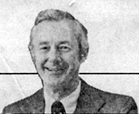 Palo Alto Stanford Heritage
Palo Alto Stanford Heritage 
The following article by Ward Winslow, originally appeared in the Palo Alto Times Tribune, Sunday, October 13, 1985. Emphasis follows the original.
PROFESSORVILLE, AS A Palo Alto neighborhood, is known nowadays for its restored old houses and its listing in the National Register of Historic Places. But I can't recall ever hearing the name while living there in my high school, college and cub reporter days.
My parents, Edward T. and Roberta Winslow, who are in their upper 80s and live in Saratoga now, remember the term from when they resided farther out Kingsley Avenue in the 1920s. And Barbara Marx Givan, a long–time resident, told a reporter in 1979 that "Professorville" was a jocular label first used around the turn of the century.
It regained vogue starting in 1969. Prof. Robert Textor bought a house there only to learn a week later that the Palo Alto Medical Clinic was planning to build a high-rise hospital nearby. Indignation didn't just nix the hospital — it sparked restorations, got the district's history dug up, and put it on the way to state and national recognition.
Professorville consists of 10 blocks between Addison Avenue and Embarcadero Road from Emerson Street to Cowper Street, and most of its shingle and clapboard houses look better today than they did 30 years ago. Lincoln and Kingsley avenues and Bryant Street are its main stems.
THE BLOCK OF RAMONA Street between Lincoln and Kingsley is the one I can tell about. We moved there in mid–1941, a few months before World War II began. Our house was an oversized bungalow that had been built by Andrew Allen Browne, a mechanical engineering professor, and his wife, Marian. Browne died in 1906, and in 1908 his widow married a widower, Prof. Charles B. Wing, who was famous both as an engineer and a Palo Alto city father, and who had built the first house in Professorville. (The professors chose their district in preference to campus sites with long–term leases, which some felt were unsound).
IT WAS AFTER THE WAR ended that the 1100 Ramona block really coalesced, in my mind, as a close–knit neighborhood.
Professors there were. Karl Brandt, who later served on President Eisenhower's Council of Economic Advisers, lived at one end in a large house facing on Kingsley and Merrill Bennett at the other, and both were with the Food Research Institute.
Around the corner across Kingsley Avenue lived J. Pearce Mitchell, Stanford registrar and professor of chemistry, and a 21–year member of the old 15–person City Council. I mention him only to remind people where Mitchell Park got its name. Actually, my memory picture is of him mounted on his bicycle, pedaling off to the campus.
The other residents weren't professors but they were distinguished. Next door to Prof. Starks lived the Wilbur W. Boltons. In fact, the Starkses and the Boltons had bought a lot between their houses and split it, giving each home a more spacious setting than other homes on the street. On our side, things were so close that we and the Ernest Becker family next door shared a common driveway which forked at the back and led to tiny one-car garages. Ernie was famous among Peninsula telephone people, for he'd begun as a teen-ager and gone through every system installation.
On the other side of us, after a few years, was Howard Pease, a renowned author of boys' books. Stanley Blois, who was connected with the Stanford Laundry, lived down the block, and at the corner of Kingsley, in the Marvins' house, Lucille Nixon had an apartment. Miss Nixon was the school curriculum coordinator who became big news as the first American not of Japanese ancestry whose haiku won her an invitation to Emperor Hirohito's poetry party. After her death in an auto–train crash, a new school at Stanford was named for her.
AT WILBUR BOLTON'S FUNERAL in April at the Methodist Church, Bishop R. Marvin Stuart finished his own remarks and asked if anyone had anything to add. As one of a parade of boys [who had] cut Wilbur's lawn, I should have stood up and said it was the block barbecue at the Boltons every summer that really made the neighborhood. Everyone came, including students both foreign and domestic who occupied spare rooms or apartments during the great postwar housing crunch.
His widow, Besse Bolton, who in the 1940s established Palo Alto's pioneering preschool family education program, and later studied with Carl Jung, was at the funeral, looking sweet as ever. But a stroke had taken her memory.
All these people are gone from the block, but some are still around. Lillian Russ, who lived with us, and Florence Becker, the second of two sisters Ernie married, are downtown. Mrs. Brandt is at Channing House [1985]. My folks rented on the block 25 years before returning to a home they owned in Saratoga. In 1941 they could have bought the Ramona Street house for about $7,000, but loans weren't easy then.
IT WAS A COSMOPOLITAN BLOCK, and it's part of why Palo Alto never has seemed provincial to me. There are lots of other professor–impacted blocks around the mid–Peninsula today, and—in those that enjoy the sort of neighborliness ours did, a healthy cultural cross–pollination is going on.
E-mail us at either webmaster@pastheritage.org or president@pastheritage.org.
![]() Palo Alto Stanford Heritage—Dedicated to the preservation of Palo Alto's historic buildings.
Palo Alto Stanford Heritage—Dedicated to the preservation of Palo Alto's historic buildings.
Copyright © 2015 Palo Alto Stanford Heritage. All rights reserved.